Abstract
Inorganic arsenic (In-As), an occupational and environmental human carcinogen, undergoes biomethylation to monomethylarsonate (MMA) and dimethylarsinate (DMA). It has been proposed that saturation of methylation capacity at high exposure levels may lead to a threshold for the carcinogenicity of In-As. The relative distribution of urinary In-As, MMA, and DMA is used as a measure of human methylation capacity. The most common pathway for elevated environmental exposure to In-As worldwide is through drinking water. We conducted a biomarker study in northern Chile of a population chronically exposed to water naturally contaminated with high arsenic content (600 micrograms/l). In this paper we present the results of a prospective follow-up of 73 exposed individuals, who were provided with water of lower arsenic content (45 micrograms/l) for 2 months. The proportions of In-As, MMA, and DMA in urine were compared before and after intervention, and the effect of other factors on the distribution of arsenic metabolites was also analyzed. The findings of this study indicate that the decrease in arsenic exposure was associated with a small decrease in the percent In-As in urine (from 17.8% to 14.6%) and in the MMA/DMA ratio (from 0.23 to 0.18). Other factors such as smoking, gender, age, years of residence, and ethnicity were associated mainly with changes in the MMA/DMA ratio, with smoking having the strongest effect. Nevertheless, the factors investigated accounted for only about 20% of the large interindividual variability observed. Genetic polymorphisms in As-methylating enzymes and other co-factors are likely to contribute to some of the unexplained variation. The changes observed in the percent In-As and in the MMA/DMA ratio do not support an exposure-based threshold for arsenic methylation in humans.
Full text
PDF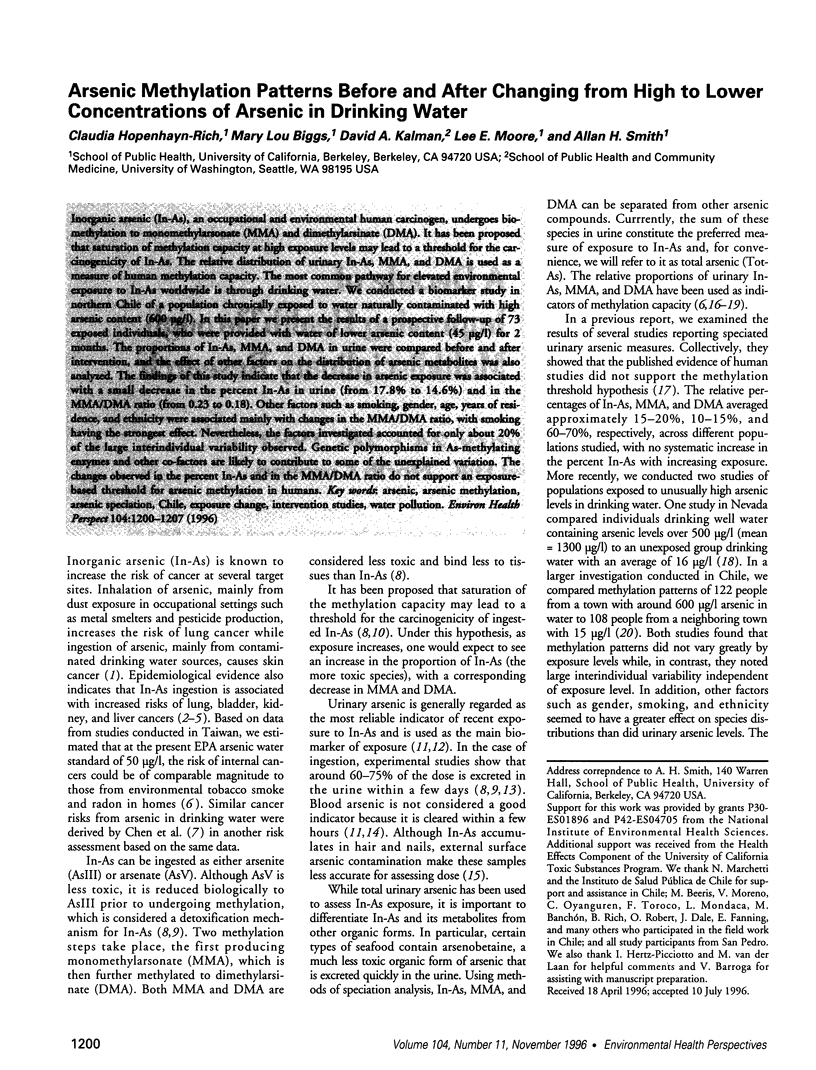
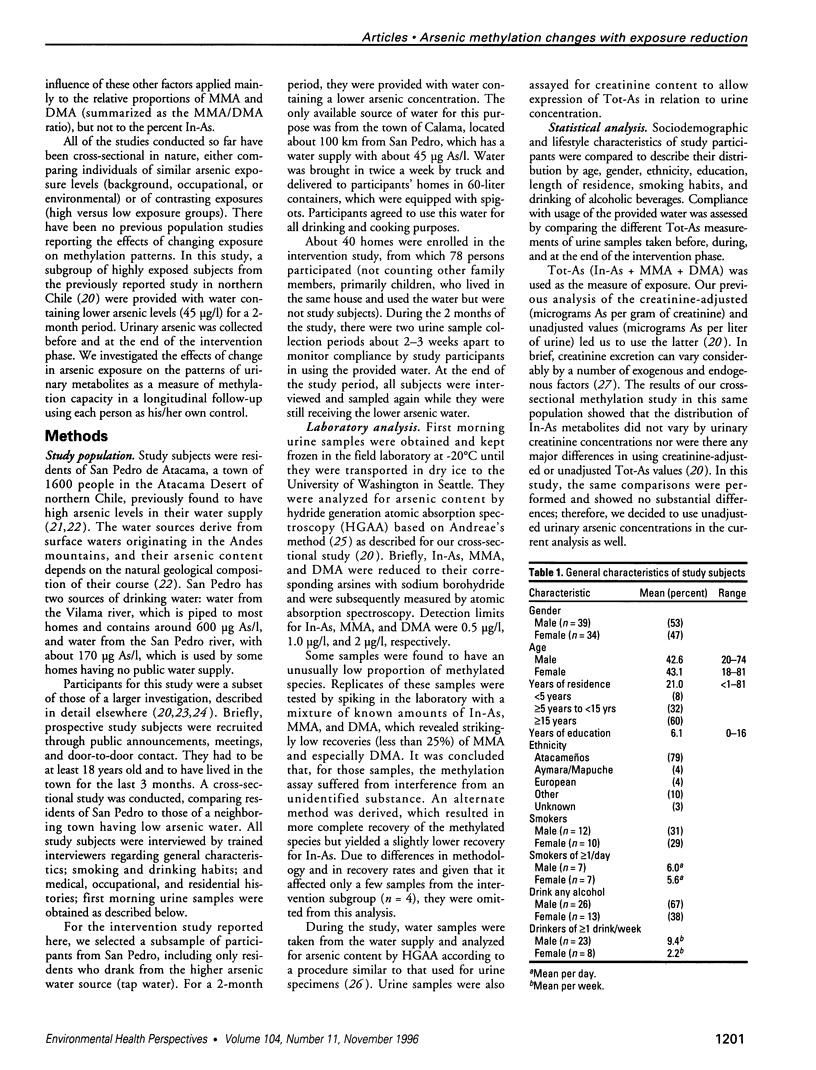
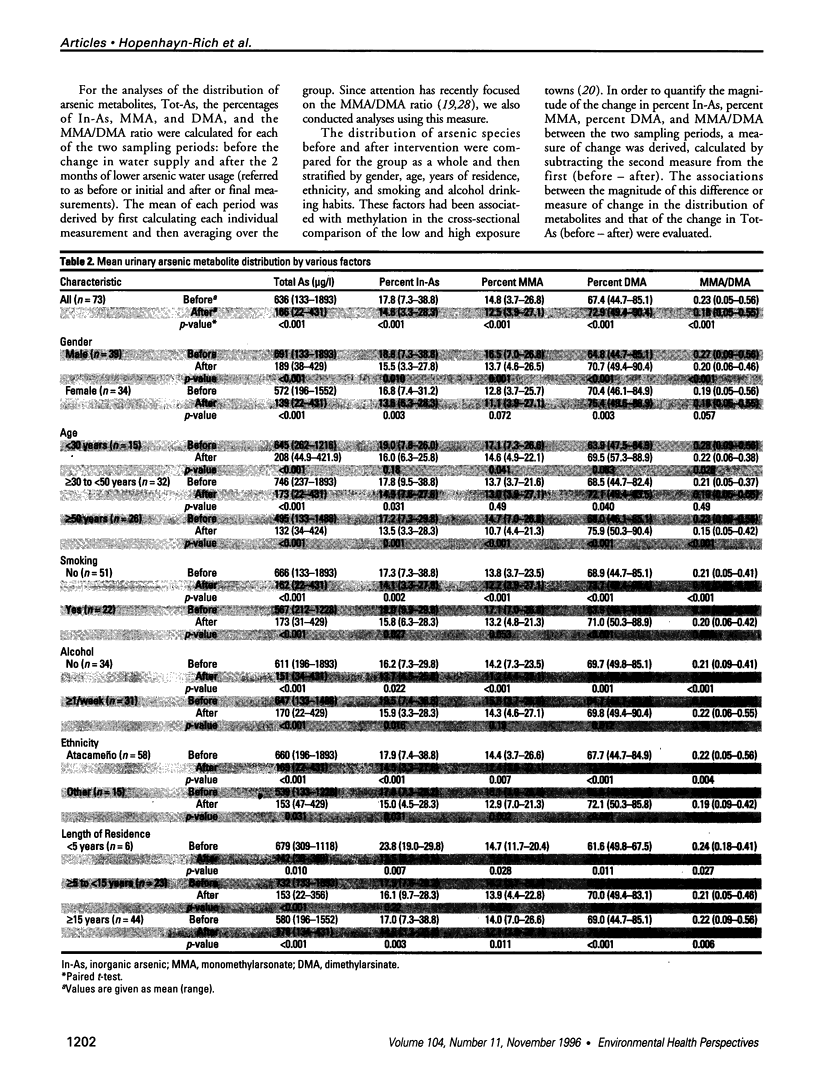
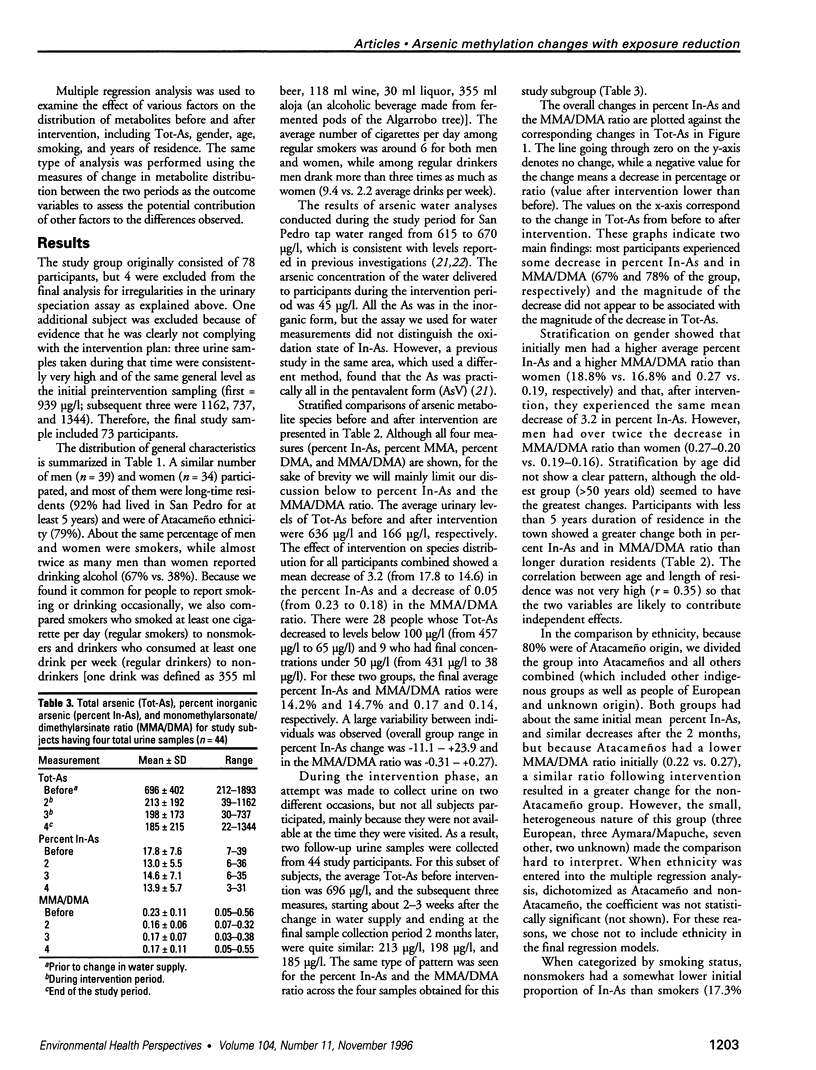
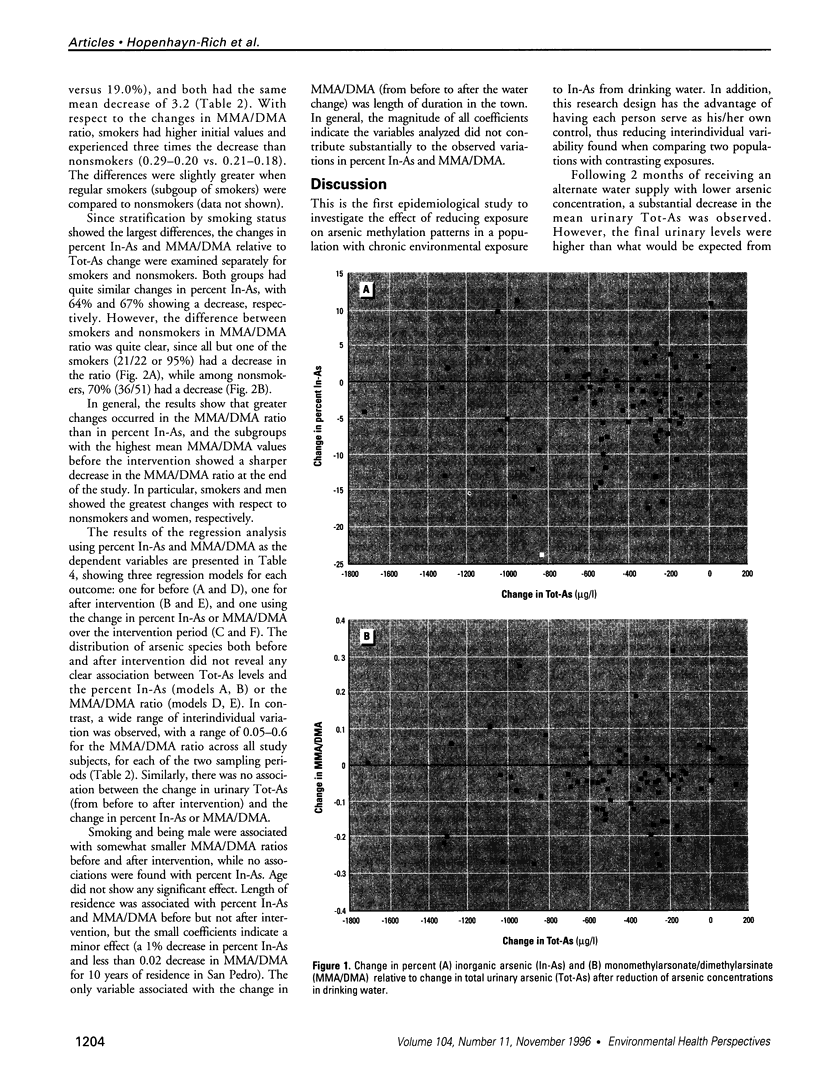
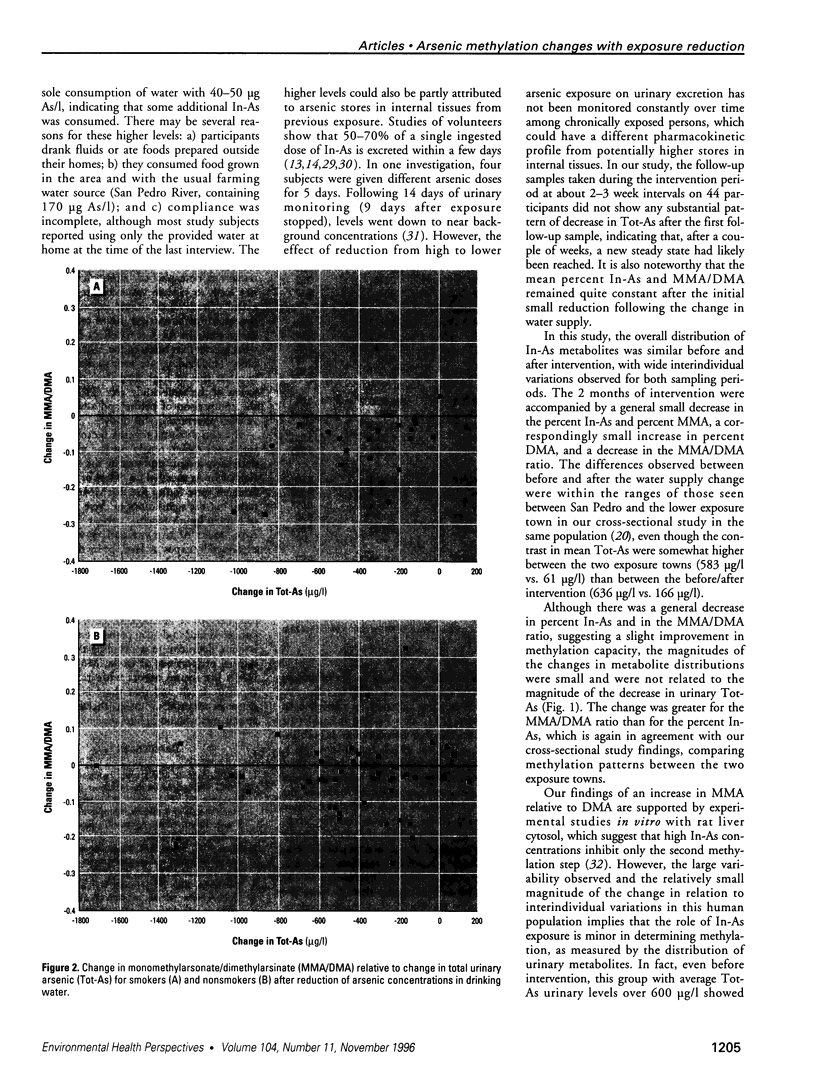
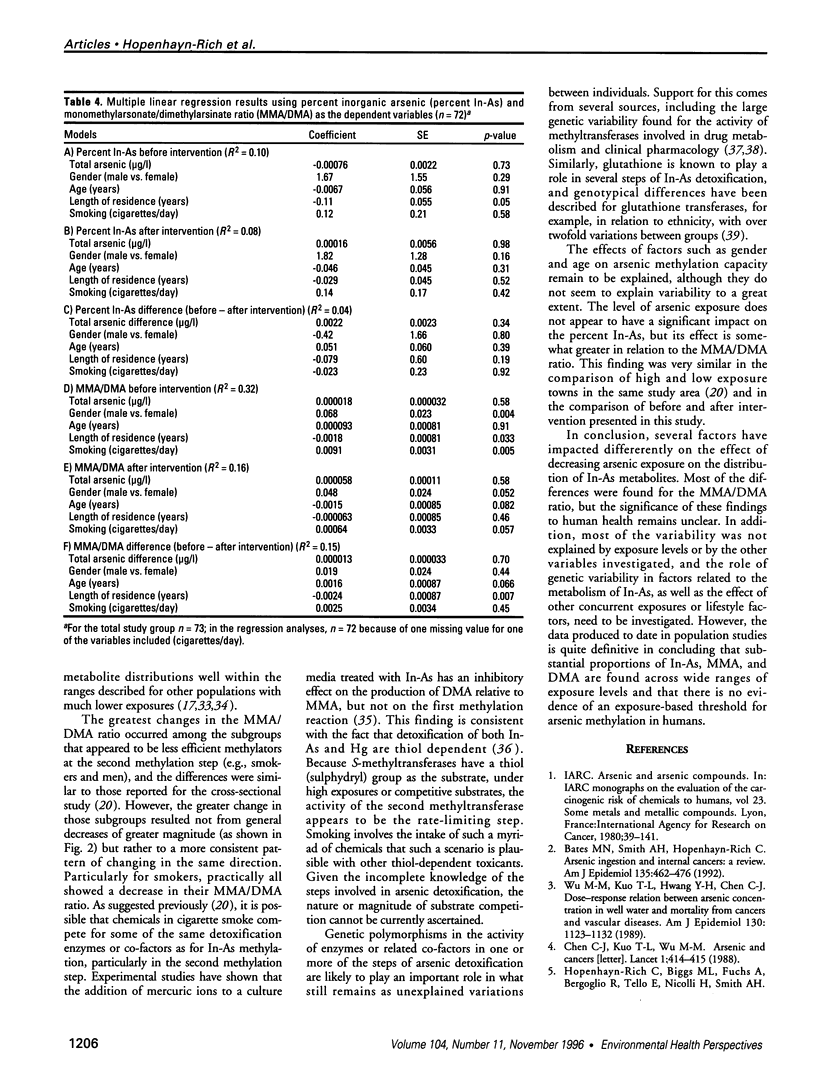
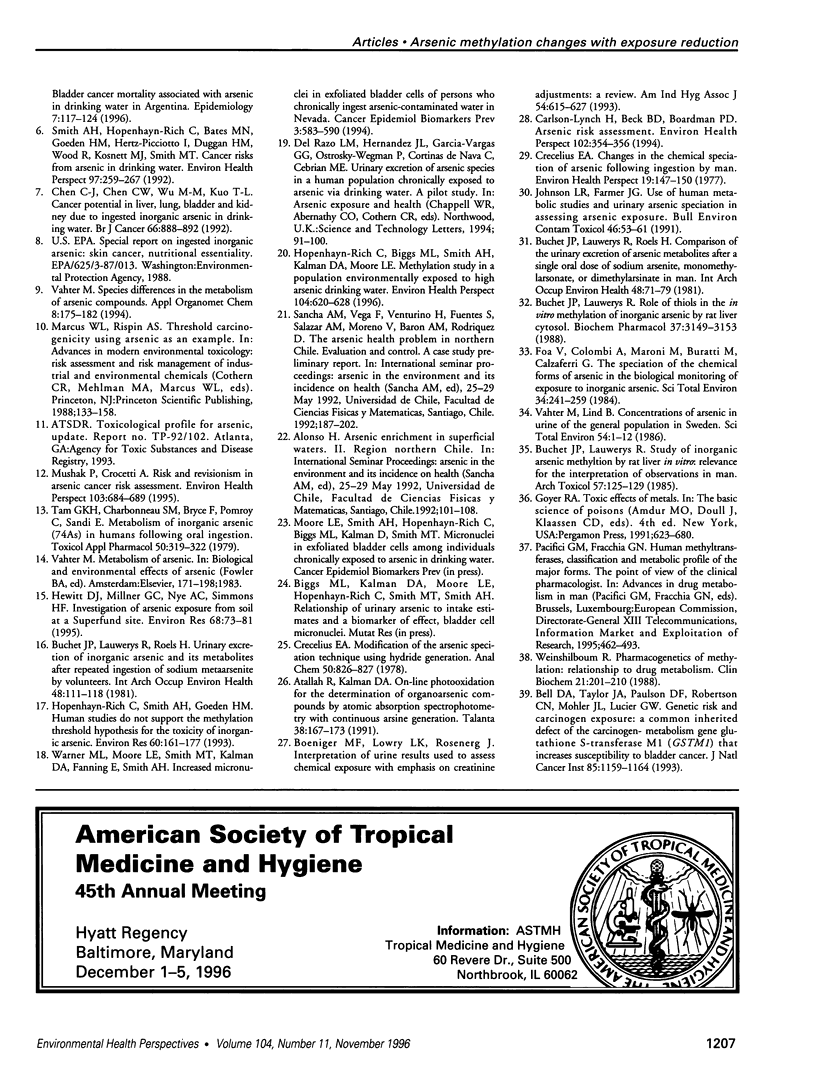
Images in this article
Selected References
These references are in PubMed. This may not be the complete list of references from this article.
- Bates M. N., Smith A. H., Hopenhayn-Rich C. Arsenic ingestion and internal cancers: a review. Am J Epidemiol. 1992 Mar 1;135(5):462–476. doi: 10.1093/oxfordjournals.aje.a116313. [DOI] [PubMed] [Google Scholar]
- Bell D. A., Taylor J. A., Paulson D. F., Robertson C. N., Mohler J. L., Lucier G. W. Genetic risk and carcinogen exposure: a common inherited defect of the carcinogen-metabolism gene glutathione S-transferase M1 (GSTM1) that increases susceptibility to bladder cancer. J Natl Cancer Inst. 1993 Jul 21;85(14):1159–1164. doi: 10.1093/jnci/85.14.1159. [DOI] [PubMed] [Google Scholar]
- Boeniger M. F., Lowry L. K., Rosenberg J. Interpretation of urine results used to assess chemical exposure with emphasis on creatinine adjustments: a review. Am Ind Hyg Assoc J. 1993 Oct;54(10):615–627. doi: 10.1080/15298669391355134. [DOI] [PubMed] [Google Scholar]
- Buchet J. P., Lauwerys R., Roels H. Comparison of the urinary excretion of arsenic metabolites after a single oral dose of sodium arsenite, monomethylarsonate, or dimethylarsinate in man. Int Arch Occup Environ Health. 1981;48(1):71–79. doi: 10.1007/BF00405933. [DOI] [PubMed] [Google Scholar]
- Buchet J. P., Lauwerys R., Roels H. Urinary excretion of inorganic arsenic and its metabolites after repeated ingestion of sodium metaarsenite by volunteers. Int Arch Occup Environ Health. 1981;48(2):111–118. doi: 10.1007/BF00378431. [DOI] [PubMed] [Google Scholar]
- Buchet J. P., Lauwerys R. Role of thiols in the in-vitro methylation of inorganic arsenic by rat liver cytosol. Biochem Pharmacol. 1988 Aug 15;37(16):3149–3153. doi: 10.1016/0006-2952(88)90313-9. [DOI] [PubMed] [Google Scholar]
- Buchet J. P., Lauwerys R. Study of inorganic arsenic methylation by rat liver in vitro: relevance for the interpretation of observations in man. Arch Toxicol. 1985 Jun;57(2):125–129. doi: 10.1007/BF00343122. [DOI] [PubMed] [Google Scholar]
- Carlson-Lynch H., Beck B. D., Boardman P. D. Arsenic risk assessment. Environ Health Perspect. 1994 Apr;102(4):354–356. doi: 10.1289/ehp.94102354. [DOI] [PMC free article] [PubMed] [Google Scholar]
- Chen C. J., Chen C. W., Wu M. M., Kuo T. L. Cancer potential in liver, lung, bladder and kidney due to ingested inorganic arsenic in drinking water. Br J Cancer. 1992 Nov;66(5):888–892. doi: 10.1038/bjc.1992.380. [DOI] [PMC free article] [PubMed] [Google Scholar]
- Crecelius E. A. Changes in the chemical speciation of arsenic following ingestion by man. Environ Health Perspect. 1977 Aug;19:147–150. doi: 10.1289/ehp.7719147. [DOI] [PMC free article] [PubMed] [Google Scholar]
- Foà V., Colombi A., Maroni M., Buratti M., Calzaferri G. The speciation of the chemical forms of arsenic in the biological monitoring of exposure to inorganic arsenic. Sci Total Environ. 1984 Mar 15;34(3):241–259. doi: 10.1016/0048-9697(84)90066-4. [DOI] [PubMed] [Google Scholar]
- Hewitt D. J., Millner G. C., Nye A. C., Simmons H. F. Investigation of arsenic exposure from soil at a superfund site. Environ Res. 1995 Feb;68(2):73–81. doi: 10.1006/enrs.1995.1010. [DOI] [PubMed] [Google Scholar]
- Hopenhayn-Rich C., Biggs M. L., Fuchs A., Bergoglio R., Tello E. E., Nicolli H., Smith A. H. Bladder cancer mortality associated with arsenic in drinking water in Argentina. Epidemiology. 1996 Mar;7(2):117–124. doi: 10.1097/00001648-199603000-00003. [DOI] [PubMed] [Google Scholar]
- Hopenhayn-Rich C., Biggs M. L., Smith A. H., Kalman D. A., Moore L. E. Methylation study of a population environmentally exposed to arsenic in drinking water. Environ Health Perspect. 1996 Jun;104(6):620–628. doi: 10.1289/ehp.96104620. [DOI] [PMC free article] [PubMed] [Google Scholar]
- Hopenhayn-Rich C., Smith A. H., Goeden H. M. Human studies do not support the methylation threshold hypothesis for the toxicity of inorganic arsenic. Environ Res. 1993 Feb;60(2):161–177. doi: 10.1006/enrs.1993.1024. [DOI] [PubMed] [Google Scholar]
- Johnson L. R., Farmer J. G. Use of human metabolic studies and urinary arsenic speciation in assessing arsenic exposure. Bull Environ Contam Toxicol. 1991 Jan;46(1):53–61. doi: 10.1007/BF01688254. [DOI] [PubMed] [Google Scholar]
- Mushak P., Crocetti A. F. Risk and revisionism in arsenic cancer risk assessment. Environ Health Perspect. 1995 Jul-Aug;103(7-8):684–689. doi: 10.1289/ehp.95103684. [DOI] [PMC free article] [PubMed] [Google Scholar]
- Smith A. H., Hopenhayn-Rich C., Bates M. N., Goeden H. M., Hertz-Picciotto I., Duggan H. M., Wood R., Kosnett M. J., Smith M. T. Cancer risks from arsenic in drinking water. Environ Health Perspect. 1992 Jul;97:259–267. doi: 10.1289/ehp.9297259. [DOI] [PMC free article] [PubMed] [Google Scholar]
- Tam G. K., Charbonneau S. M., Bryce F., Pomroy C., Sandi E. Metabolism of inorganic arsenic (74As) in humans following oral ingestion. Toxicol Appl Pharmacol. 1979 Sep 15;50(2):319–322. doi: 10.1016/0041-008x(79)90157-1. [DOI] [PubMed] [Google Scholar]
- Vahter M., Lind B. Concentrations of arsenic in urine of the general population in Sweden. Sci Total Environ. 1986 Oct;54:1–12. doi: 10.1016/0048-9697(86)90252-4. [DOI] [PubMed] [Google Scholar]
- Warner M. L., Moore L. E., Smith M. T., Kalman D. A., Fanning E., Smith A. H. Increased micronuclei in exfoliated bladder cells of individuals who chronically ingest arsenic-contaminated water in Nevada. Cancer Epidemiol Biomarkers Prev. 1994 Oct-Nov;3(7):583–590. [PubMed] [Google Scholar]
- Weinshilboum R. Pharmacogenetics of methylation: relationship to drug metabolism. Clin Biochem. 1988 Aug;21(4):201–210. doi: 10.1016/s0009-9120(88)80002-x. [DOI] [PubMed] [Google Scholar]
- Wu M. M., Kuo T. L., Hwang Y. H., Chen C. J. Dose-response relation between arsenic concentration in well water and mortality from cancers and vascular diseases. Am J Epidemiol. 1989 Dec;130(6):1123–1132. doi: 10.1093/oxfordjournals.aje.a115439. [DOI] [PubMed] [Google Scholar]






